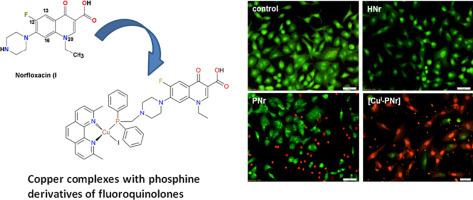Journal of Inorganic Biochemistry ( IF 3.8 ) Pub Date : 2018-01-09 , DOI: 10.1016/j.jinorgbio.2018.01.008 Aleksandra Bykowska , Urszula K. Komarnicka , Małgorzata Jeżowska-Bojczuk , Agnieszka Kyzioł

|
In this paper, we present a comparative study on the cytotoxic mode of action of copper(I) and copper(II) complexes with phosphine derivatives of fluoroquinolone antibiotics (ciprofloxacin HCp and norfloxacin HNr). The in vitro cytotoxic activity of four new compounds was tested against two selected cancer cell lines. All complexes exhibited much better cytotoxicity against both cell lines than unmodified fluoroquinolone antibiotics, their phosphines (PCp, PNr), chalcogenide derivatives (oxides: OPCp, OPNr; sulfides: SPCp, SPNr and selenides: SePCp, SePNr) and previously described by us complexes with phosphines derived from different fluoroquinolones: lomefloxacin (HLm) and sparfloxacin (HSf) as well as cisplatin. Apoptosis, observed at a great predominance, was induced by all studied complexes. Importantly, it was concluded that coordination compounds with Cu(I) ion ([CuI-PNr] and [CuI-PCp]) were much more active than those with Cu(II) ion ([OPNr-CuII], [OPCp-CuII]), even though the highest efficacy to produce reactive oxygen species, participating in overall cytotoxicity, was proved for copper(II) complexes among all studied compounds. Herein, we discuss not only results obtained for copper(I)/(II) complexes with phosphines derived from HNr and HCp but we also compare them to previously described data for complexes with HLm and HSf derivatives. This is the first insight into a structure–activity relationship of copper complexes with phosphine derivatives of fluoroquinolone antibiotics.
中文翻译:

Cu I和Cu II与氟喹诺酮类抗生素的膦衍生物配合物–细胞毒性作用模式的比较研究
在本文中,我们对铜(I)和铜(II)与氟喹诺酮类抗生素的环磷酰胺衍生物(环丙沙星HCp和诺氟沙星HNr)的细胞毒性作用模式进行了比较研究。在体外的四个新的化合物的细胞毒活性是反对两个选定的癌细胞系进行测试。与未修饰的氟喹诺酮类抗生素,其膦(PCp,PNr),硫属化物衍生物(氧化物:OPCp,OPNr;硫化物:SPCp,SPNr和硒化物:SePCp,SePNr)相比,所有复合物对两种细胞系均表现出更好的细胞毒性。),并由我们先前描述了与衍生自不同氟喹诺酮类化合物的膦形成的络合物:洛美沙星(HLm)和司巴沙星(HSf)以及顺铂。所有研究过的复合物均能诱导细胞凋亡。重要的是,得出的结论是,具有Cu(I)离子的配位化合物([Cu I -PNr]和[Cu I -PCp])比具有Cu(II)离子的配位化合物([OPNr-Cu II ],[ OPCp-Cu II ]),尽管所有研究化合物中的铜(II)配合物都被证明具有最高的产生活性氧的功效,但参与了总体细胞毒性作用。在本文中,我们不仅讨论了铜(I)/(II)与衍生自HNr和HCp的膦的配合物的结果,还将它们与先前描述的HLm和HSf衍生物配合物的数据进行了比较。这是首次发现铜配合物与氟喹诺酮抗生素的膦衍生物之间的结构-活性关系。











































 京公网安备 11010802027423号
京公网安备 11010802027423号